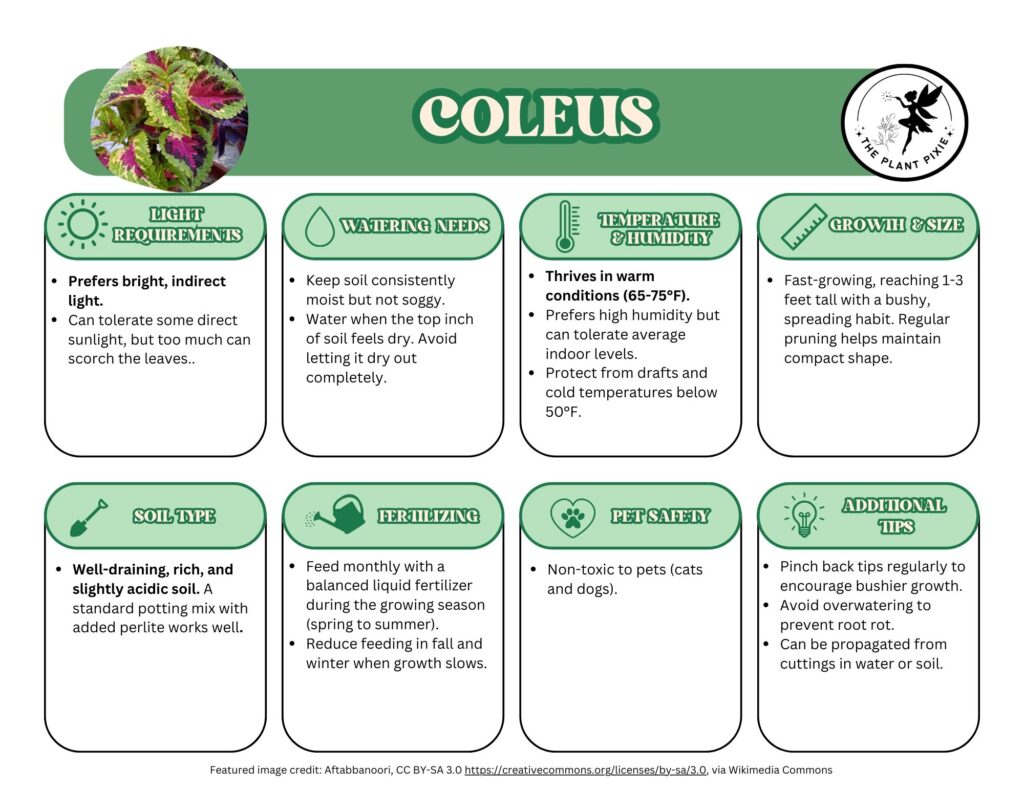
1. Botanical Overview:

- Species and Varieties:
- Coleus blumei is the most commonly grown species, with various cultivars offering diverse colors and leaf patterns (red, purple, yellow, green, and multicolored).
- Hybrid varieties: Coleus x hybridus—crosses that produce unique colors and leaf shapes.
- Key characteristics: Lush, vibrant foliage with striking variegation.
- Growth Habit:
- Coleus is typically grown as a bushy, low-maintenance shrub or ground cover (outdoors) or as a compact, colorful houseplant.
- Grows as a compact, bushy plant (1–3 feet tall) and produces small, inconspicuous flowers in summer (often pruned to keep the focus on the foliage).
2. Ideal Growing Conditions for Coleus:
- Light:
- Prefers bright, indirect light but can tolerate some direct sunlight, especially in the morning or late afternoon.
- While it thrives in full sun outdoors, Coleus grown indoors should be placed in a bright spot to maintain vibrant colors.
- Too much direct sun can cause leaf burn or fading of the colors.
- Temperature:
- Ideal temperature range: 65°F to 75°F (18°C–24°C).
- Sensitive to cold temperatures, so best to keep it in warm environments. It can’t tolerate frost.
- Humidity:
- Prefers moderate to high humidity levels (50% and above).
- If grown indoors, consider using a humidity tray, misting, or a room humidifier during dry months to maintain healthy leaves.
- Soil:
- Well-draining, slightly acidic to neutral soil (pH 6.0–7.0).
- A light, loamy potting mix or general-purpose indoor plant soil with some added perlite or vermiculite for good drainage works well.
3. Watering Coleus:
- Watering Basics:
- Keep soil consistently moist, but not soggy.
- Water when the top inch of soil feels dry to the touch.
- Be sure the pot has good drainage to avoid waterlogged soil and root rot.
- Signs of Overwatering:
- Yellowing leaves, soft stems, and root rot.
- Soil that stays constantly wet.
- Signs of Underwatering:
- Wilting, dry, crispy leaves, especially at the edges.
- Dry, cracked soil.
- Watering Tips:
- Water thoroughly, allowing water to drain from the bottom of the pot.
- Reduce watering during the winter months when growth slows down.
- Avoid letting the plant sit in standing water or soggy soil to prevent root rot.
4. Fertilizing Coleus:
- When to Fertilize:
- During the growing season (spring and summer), once a month.
- Reduce or stop fertilizing in fall and winter when the plant is not actively growing.
- Type of Fertilizer:
- Use a balanced, water-soluble fertilizer (e.g., 10-10-10) diluted to half strength.
- Alternatively, you can use a slow-release fertilizer for outdoor plants.
- How to Fertilize:
- Apply fertilizer after watering to avoid root burn.
- Be cautious not to over-fertilize, as this can cause leggy growth or reduce leaf color vibrancy.
- Signs of Over-Fertilizing:
- Yellow or burnt leaf edges, leggy growth, or excessive leaf drop.
- If over-fertilized, flush the soil with water to remove excess nutrients.
5. Common Issues and How to Solve Them:
- Leaf Fading or Loss of Color:
- Causes: Insufficient light, poor nutrition, or temperature stress.
- Solutions: Move the plant to a brighter location and ensure it’s in a warm, stable environment.
- Yellowing or Drooping Leaves:
- Causes: Overwatering, underwatering, or pests.
- Solutions: Adjust watering practices and check for pests (e.g., aphids, spider mites).
- Leggy Growth:
- Causes: Lack of light or improper pruning.
- Solutions: Move the plant to a brighter spot and trim leggy stems to encourage new growth and bushier shape.
- Pests:
- Common pests: Aphids, spider mites, whiteflies, and mealybugs.
- Solutions: Regularly inspect leaves for pests and treat with insecticidal soap or neem oil.
- Root Rot:
- Causes: Overwatering or poor drainage.
- Solutions: Check the roots for rot and repot into fresh, well-draining soil. Make sure the pot has drainage holes.
6. Pruning and Maintenance:
- Why Prune Coleus?
- Pruning encourages bushier growth and maintains a compact shape.
- Helps prevent the plant from becoming too leggy or overgrown.
- When to Prune:
- Prune in the spring or summer during the growing season.
- Remove dead or damaged leaves and spent flowers.
- Pinch back leggy stems to encourage new branching.
- How to Prune:
- Use clean, sharp scissors or pruning shears.
- Cut back long stems to promote fuller growth.
- Trim the plant regularly to maintain its shape and prevent it from flowering (unless you want to allow it to bloom).
7. Repotting Coleus:
- When to Repot:
- Repot every 1-2 years or when the plant becomes root-bound.
- Signs that it’s time to repot: Roots growing out of drainage holes, slower growth, or the plant becomes top-heavy.
- Best Potting Tips:
- Choose a pot that is 1-2 inches larger in diameter than the current pot.
- Make sure the new pot has proper drainage holes.
- Repotting Steps:
- Gently remove the plant from its old pot and check the roots for any signs of damage or rot.
- Use fresh, well-draining potting soil.
- Water thoroughly after repotting and keep the plant in a bright, warm spot to help it adjust.
8. Propagation of Coleus:
- How to Propagate:
- Coleus is easy to propagate through stem cuttings.
- Take a cutting from a healthy, non-flowering stem that is at least 4-6 inches long.
- Place the cutting in water or directly into moist soil. Roots will typically form in 1-2 weeks.
- Propagation Tips:
- Keep the cutting in a warm, bright location with high humidity to encourage root growth.
- Change the water regularly if propagating in water.
- Once roots have developed, transplant the cutting into its own pot with fresh soil.
- Speed of Propagation:
- Coleus propagates quickly, and new plants are often ready to be potted in a few weeks.
9. Benefits of Owning Coleus:
- Vibrant Foliage:
- The primary appeal of Coleus is its stunning, colorful leaves that come in a variety of shades, including red, purple, yellow, green, and multi-colored patterns.
- Easy to Care For:
- Coleus is a low-maintenance plant that requires little attention beyond regular watering, pruning, and occasional fertilizing.
- Versatility:
- Can be grown as a houseplant, in outdoor containers, or as part of garden beds. Great for adding color to any space.
- Non-Toxic to Pets:
- Unlike many ornamental plants, Coleus is non-toxic to both cats and dogs, making it a safe choice for pet-friendly households.
10. Fun Facts About Coleus:
- Name Origin: The name “Coleus” comes from the Greek word kóllēos, meaning “glue,” referring to the sticky sap that some species produce.
- Historical Trivia: Coleus was originally used as a medicinal plant in traditional cultures before becoming popular as an ornamental plant.
- Flowering: While the small flowers are not very showy, they are occasionally allowed to bloom for a short period, after which pruning encourages the plant to focus on foliage.
Featured image credit: Aftabbanoori, CC BY-SA 3.0 https://creativecommons.org/licenses/by-sa/3.0, via Wikimedia Commons

